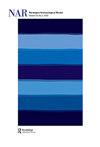Working at the Sharp End: From Bone and Antler to Early Mesolithic Life in Northern Europe
IF 1.1
3区 历史学
0 ARCHAEOLOGY
引用次数: 13
Abstract
As an academic whose research area, while undoubtedly Mesolithic, includes few early sites and little preserved bone and antler, this handsome volume introduces me, tantalisingly, to a whole world of wonders that does exist in other places. In common with many thematic volumes today, the collection of papers originated in a workshop, in this case, held in 2016 to discuss the re-evaluation of the Early Holocene site at Hohen Viecheln (Mecklenburg-Vorpommern, Germany). Special interest lay in the remarkable assemblages of worked bone and antler from the site, with particular reference to barbed points, and there was also an intention to embed the research into ‘the international research landscape’ (Acknowledgements, 14), through the inclusion of related studies from the UK to the Urals. The title sets a further goal: to move from raw materials and artefacts towards an interpretation of lifeways. Careful design takes the volume from the particular to the general. Details of the site at Hohen Viecheln set the scene (Groß, Lübke, Meadows and Jantzen) and include summaries of stratigraphy and dating which help to provide an overview of the archaeological context. Information on the bone and antler artefacts incorporates a comprehensive catalogue and fourteen photographic plates supplement numerous line drawings. Consideration of decorative motifs is presented in addition to detail regarding manufacturing techniques. There is a useful description of the issues when dating old (conserved) material (Meadows, Boudin, Groß, Jantzen, Lübke and Wild) and an analysis of the bone and antler artefacts with reference to the wider Maglemosian world (David). Site-specific material continues with an evaluation of the antler headdresses (Wild) and the suggestion that instead of forming part of socially restricted shamanic costumes these pieces are more likely to have been in wider use, perhaps in conjunction with ritual dancing – an interpretation once proposed by Clark for the frontlets from Star Carr (Clark 1954, p. 174), though now often eschewed in favour of shamanic use (Little et al. 2016). Finally, there is a nice personal touch (Brinch Petersen) in the exploration of the possibility that two decorated bone mattocks from the site may be the product of a visitor from Zealand due to specific details of the decoration which are paralleled at sites such as Sværdborg I. While this is an avowedly speculative interpretation it is a useful reminder that our archaeologies are nothing if they do not address the human scale. From here we move to the wider context of Hohen Viecheln and its osseous assemblages. A general overview of the industries of northeast Germany (Gramsch) poses some important questions relating to the relative significance of animal bone as a resource and its preservation today. The implications of peat bogs as a reservoir of material are raised alongside the fact that, in在尖头工作:从骨头和鹿角到北欧的早期中石器时代生活
作为一名学者,我的研究领域无疑是中石器时代,包括很少的早期遗址和很少保存的骨头和鹿角,这本漂亮的书诱人地向我介绍了一个在其他地方确实存在的整个奇迹世界。与今天的许多专题卷一样,该文集起源于2016年举行的一次研讨会,讨论了对Hohen Viecheln(梅克伦堡-前波莫瑞,德国)早全新世遗址的重新评估。特别感兴趣的是来自该地点的工作骨和鹿角的显著组合,特别是关于倒刺点,并且还打算通过包括从英国到乌拉尔的相关研究,将研究嵌入“国际研究景观”(致谢,14)。标题设定了一个进一步的目标:从原材料和人工制品转向对生活方式的解释。精心的设计将体积从特殊变为一般。Hohen Viecheln遗址的细节设定了场景(Groß, l bke, Meadows和Jantzen),包括地层学和年代测定的摘要,有助于提供考古背景的概述。关于骨头和鹿角文物的信息包括一个全面的目录和十四张照片,补充了大量的线条图。除了有关制造技术的细节外,还考虑了装饰图案。在对古老(保存的)材料(Meadows, Boudin, Groß, Jantzen, l bke和Wild)进行年代测定时,对这些问题进行了有用的描述,并对骨头和鹿角人工制品进行了分析,参考了更广泛的Maglemosian世界(David)。特定地点的材料继续对鹿角头饰进行了评估(Wild),并建议这些头饰不是社会上受限制的萨满服装的一部分,而是更有可能被广泛使用,也许与仪式舞蹈结合在一起——Clark曾对Star Carr (Clark 1954, p. 174)的前饰提出了一种解释,尽管现在经常避免使用萨满(Little et al. 2016)。最后,有一个很好的个人接触(Brinch Petersen)在探索的可能性,从现场得到的两个装饰骨冢可能是来自新西兰的游客的产品,因为装饰的具体细节与sv æ rrdborg i等遗址相似。虽然这是一个公开的推测性解释,但它是一个有用的提醒,我们的考古学如果不解决人类的规模,就什么都不是。从这里,我们转向Hohen Viecheln和它的骨骼组合的更广泛的背景。对德国东北部工业的总体概述(格兰施)提出了一些与动物骨骼作为一种资源及其保存的相对意义有关的重要问题。泥炭沼泽作为物质储藏库的含义随着以下事实而被提出
本文章由计算机程序翻译,如有差异,请以英文原文为准。
求助全文
约1分钟内获得全文
求助全文
来源期刊

Norwegian Archaeological Review
ARCHAEOLOGY-
CiteScore
2.10
自引率
0.00%
发文量
13
期刊介绍:
Norwegian Archaeological Review published since 1968, aims to be an interface between archaeological research in the Nordic countries and global archaeological trends, a meeting ground for current discussion of theoretical and methodical problems on an international scientific level. The main focus is on the European area, but discussions based upon results from other parts of the world are also welcomed. The comments of specialists, along with the author"s reply, are given as an addendum to selected articles. The Journal is also receptive to uninvited opinions and comments on a wider scope of archaeological themes, e.g. articles in Norwegian Archaeological Review or other journals, monographies, conferences.
 求助内容:
求助内容: 应助结果提醒方式:
应助结果提醒方式:


